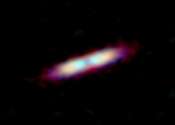ALMA spots metamorphosing aged star
An international team of astronomers using the Atacama Large Millimeter/submillimeter Array (ALMA) captured the very moment when an old star first starts to alter its environment. The star has ejected high-speed bipolar gas ...









